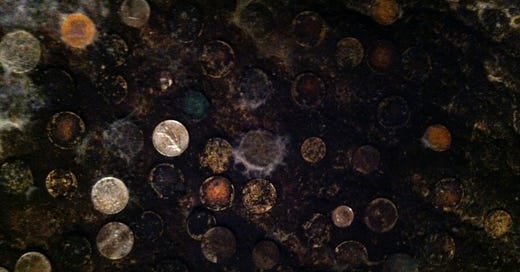AFTER COVID-19 - Wine versus disinfectants
Good winemaking hygiene is not the same as hospital hygiene.
On a jog down the boulevard de Belleville yesterday, I passed a street cleaner in protective gear spraying something on the streets. I held my breath for a block, concerned it could be hazardous. Later I was relieved to learn that Paris has, for now, resisted calls to rinse the streets with bleach in misguided efforts to fight COVID-19.
Today France emerges from confinement (for now). Like everywhere else on earth, we're emerging into an era of disinfection paranoia.
It's worth being concerned about what this portends for artisanal production and service of food and wine. For, as any winemaker knows, sterile disinfection is not the same thing as good hygiene. Many of the world's greatest cellars - like Saumur's Clos Rougeard, pictured above - are caked in mould to an extent that would be illegal in the USA. The mould is not bad mould; its maintenance is a form of hygiene in itself. As the saying goes, nature abhors a vacuum. If you get rid of all fungi and bacteria, even the benign ones, you clear the field for the bad ones.
Pioneering Languedoc vigneron - and noted natural wine skeptic - Olivier Jullien went all the way to the Tokay cellars of Hungary to source mould for his cellar walls. "I felt it smelled the best there," he explains. He compares inoculating his cellar walls with mould to the practice of inoculating tanks with yeasts: by conquering the milieu with a benign presence, one resists bacterial invasion. "For those who add yeast to protect the milieu, there’s a real logic behind it," he observes. "It’s another way to view hygiene."
No one working in wine disagrees that hygiene itself is of capital importance. Asked what he considered the greatest discovery in the improvement of wine quality, in the interview published as Le Vin en Question,* the famed oenologist and natural wine forefather Jules Chauvet replied simply, "It is hygiene." Great natural winemakers are maniacal about it. Fleurie's Yvon Métras rinses his cellar floor with water before and after practically every procedure. Between each press, his ancient wooden press is disassembled and meticulously scrubbed down with alcohol distilled from his own grape marc. But the only time he ever disinfects a piece of equipment with anything stronger is if that piece of equipment has been loaned to another winemaker.
Indeed, even more conventional wine authorities advise against disinfectant use in cellar maintenance. The renowned oenologist Max Leglise summarises the situation thusly in his 1994 book Vinifications & Fermentations: Les méthodes biologiques appliquées à la vinification & à l'oenologie:
An observation in situ, which totally escapes industrial microbiology, has over several decades shown us that the principal source of yeast inoculation of harvests is conducted by yeast spores which perpetuate themselves in the vinification site, notably on the rough surfaces of tanks and vinification materials.
It is thus essential to preserve this spontaneous and natural flora with an asepsis with regard to exterior germs, but excluding all forms of antiseptic which would destroy this high quality native yeast population. [my translation]
Elsewhere in the book, Leglise notes that the chief drawback to stainless steel vinification tanks, so easy to disinfect, is that they "retain very few yeast spores or bacteria" after washing, and so are poorly adapted to spontaneous fermentation.
The late-20th century rise of stainless steel vinification tanks paralleled the rise of commercial yeast inoculation. To save labor costs and reduce maintenance hassle, winemakers adopted steel tanks that could be easily washed. In doing so, they further impoverished their native yeast populations, already under sustained attack from pesticide use in farming. This created a need for commercial yeast inoculation, something Leglise advised for mass-market table wines, but considered "inconceivable" for vins de cru.
We all know which way this turned out. Today almost all conventional wines are yeasted, vin de cru or otherwise.
Even before the arrival of COVID-19, much of how we produce and consume other foodstuffs has been conditioned by similar compromises between quality and industrial hygiene. In Paris restaurants, as elsewhere, it's rare to receive cheese plates or terrines at correct room temperature - when they actually have flavour - because restaurants are legally mandated to keep them in the fridge, even during service. Perhaps the most egregious example is that of eggs, which do not require refrigeration for conservation unless producers wash off their natural protective coating, as is legally required in the USA.
This cultural peculiarity is widely chalked up to American squeamishness and fears of salmonella (which latter is not prevented by washing eggs). Rarely do the perennial articles on the subject probe into the origins of American squeamishness and salmonella fears, which have legitimate roots in the historical excesses of factory farming in America.
In a better world, laws could address the scale of food production and service establishments, preventing them from becoming so big as to require draconian regimes of industrial hygiene. In our world, laws more commonly mandate that small, professional artisans working according to quality-minded tradition are obliged to operate as if they were large hospitals.
Now, of course, is not really the time to question the importance of hospitals. But as we emerge into a shook-up, highly alarmed world, we should take care to ensure that the hygienic ideology of the hospital - a site intended to receive diverse infections, necessarily requiring frequent sterile disinfection - not be permitted to extend, after COVID-19, to healthy, small-scale farms, wineries, and restaurants.
At stake is whatever's left of our besieged food culture.
Related Links
A peek inside Yvon Métras' cuvage during vinification period 2015 at Wine Terroirs.



